outlet BUICK CENTURY 1996 Owners Manual
[x] Cancel search | Manufacturer: BUICK, Model Year: 1996, Model line: CENTURY, Model: BUICK CENTURY 1996Pages: 340, PDF Size: 17.61 MB
Page 6 of 340
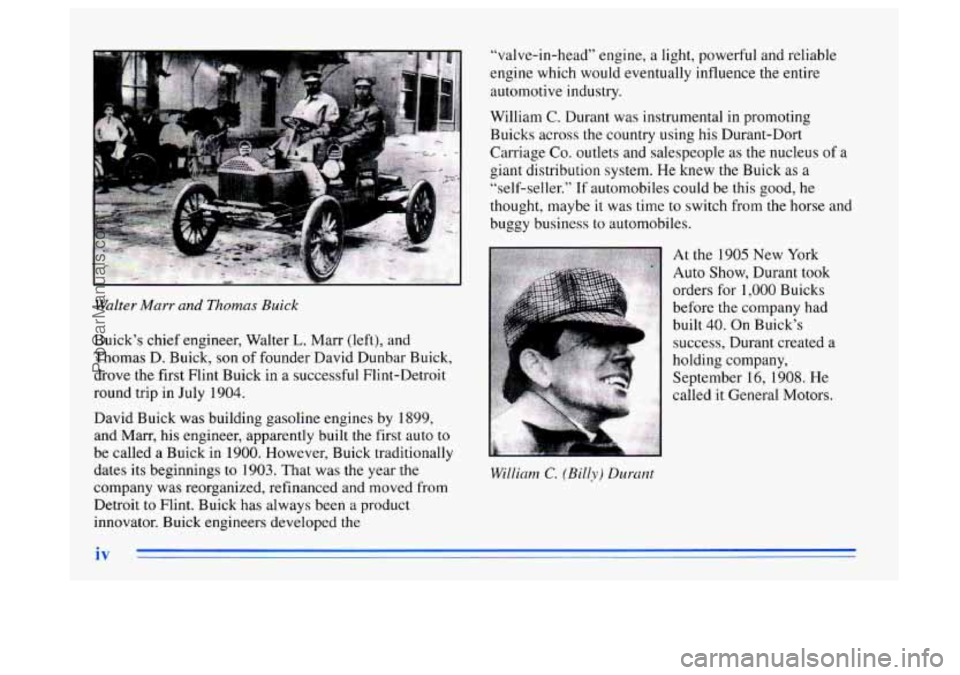
Walter Marr and Thomas Buick
Buick’s chief engineer, Walter L. Marr (left), and
Thomas
D. Buick, son of founder David Dunbar Buick,
drove the first Flint Buick in a successful Flint-Detroit
round trip in July 1904.
David Buick was building gasoline engines by 1899,
and Marr, his engineer, apparently built
the first auto to
be called
a Buick in 1900. However, Buick traditionally
dates its beginnings
to 1903. That was the year the
company was reorganized, refinanced and moved from
Detroit to Flint. Buick has always been a product
innovator. Buick engineers developed the “valve-in-head”
engine,
a light, powerful and reliable
engine which would eventually influence the entire
automotive industry.
William
C. Durant was instrumental in promoting
Buicks across the country using his Durant-Dort Carriage Co. outlets and salespeople
as the nucleus of a
giant distribution system. He knew the Buick as a
“self-seller.”
If automobiles could be this good, he
thought, maybe
it was time to switch from the horse and
buggy business
to automobiles.
At the 1905 New York
Auto Show, Durant took
orders for
1,000 Buicks
built
40. On Buick’s
before
the company had
success, Durant created
a
holding company,
September 16, 19081.
He
1 called it General Motors.
William C. (Billy) Durant
ProCarManuals.com
Page 65 of 340
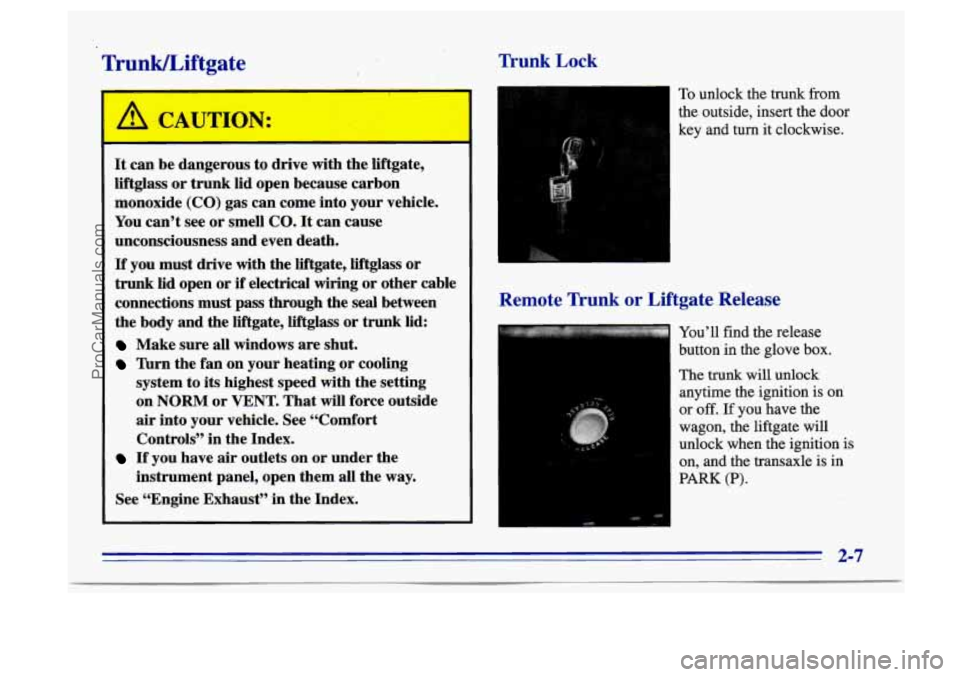
TrunkLiftgate Trunk Lock
- ~- c-
A CAUTION:
It can be dangerous to drive with the liftgate,
liftglass or trunk lid open because carbon
monoxide (CO) gas can come into your vehicle.
You can’t see or smell
CO. It can cause
unconsciousness and even death.
If you must drive with the liftgate, liftglass or
trunk lid open or
if electrical wiring or other cable
connections must pass through the seal between
the body and the liftgate, liftglass or trunk lid:
Make sure all windows are shut.
Turn the fan on your heating or cooling
system to its highest speed with the setting
on
NORM or VENT. That will force outside
air into your vehicle. See “Comfort
Controls” in the Index.
If you have air outlets on or under the
instrument panel, open them all the
way.
See “Engine Exhaust” in the Index.
To unlock the trunk from
the outside, insert the door
key and turn it clockwise.
Remote Trunk or Liftgate Release
You’ll find the release
button in the glove box.
The trunk will unlock
anytime the ignition is on
or
off. If you have the
wagon, the liftgate wi1.l
unlock when the ignition is
on, and the transaxle is in
PARK (P).
2-7
ProCarManuals.com
Page 73 of 340
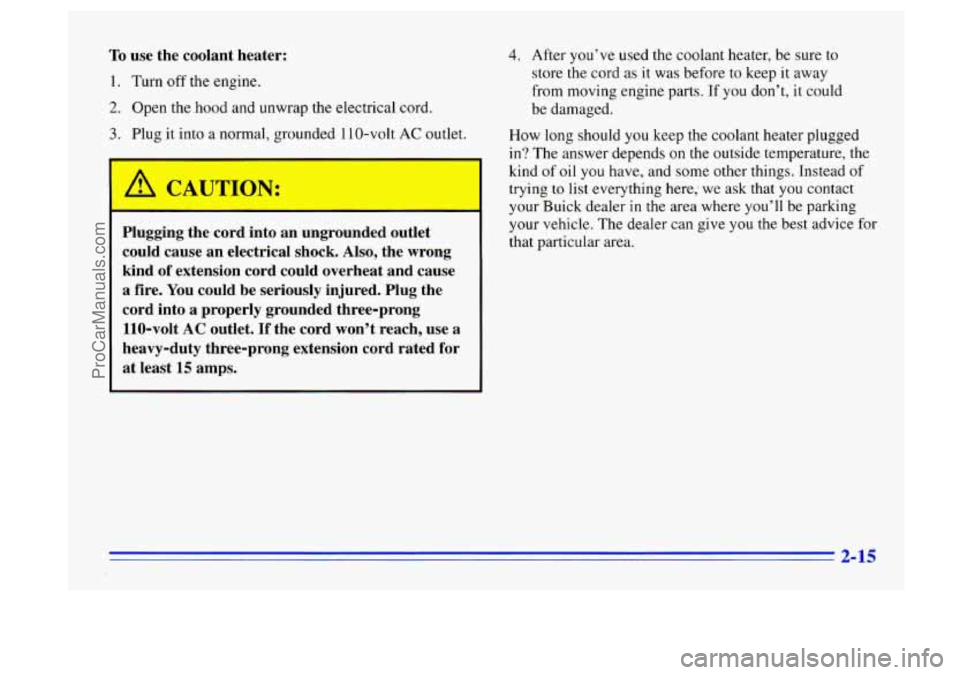
10 use the coolant heater:
1. Turn off the engine.
2. Open the hood and unwrap the electrical cord.
3. Plug it into a normal, grounded 110-volt AC outlet.
could cause an electrical shock. Also, the wrong
kind
of extension cord could overheat and cause
a fire. You could be seriously injured. Plug the
cord into
a properly grounded three-prong
110-volt
AC outlet. If the cord won’t reach, use a
heavy-duty three-prong extension cord rated for
at least
15 amps.
4. After you’ve used the coolant heater, be sure to
store the cord as it
was before to keep it away
from moving engine parts. If
you don’t, it could
be damaged.
How long should you keep the coolant heater plugged
in? The answer depends on the outside temperature, the
kind
of oil you have, and some other things. Instead of
trying to list everything here; we ask that you contact
your Buick dealer
in the area where you’ll be parking
your vehicle. The dealer can give
you the best advice for
that particular area.
2-15
ProCarManuals.com
Page 120 of 340
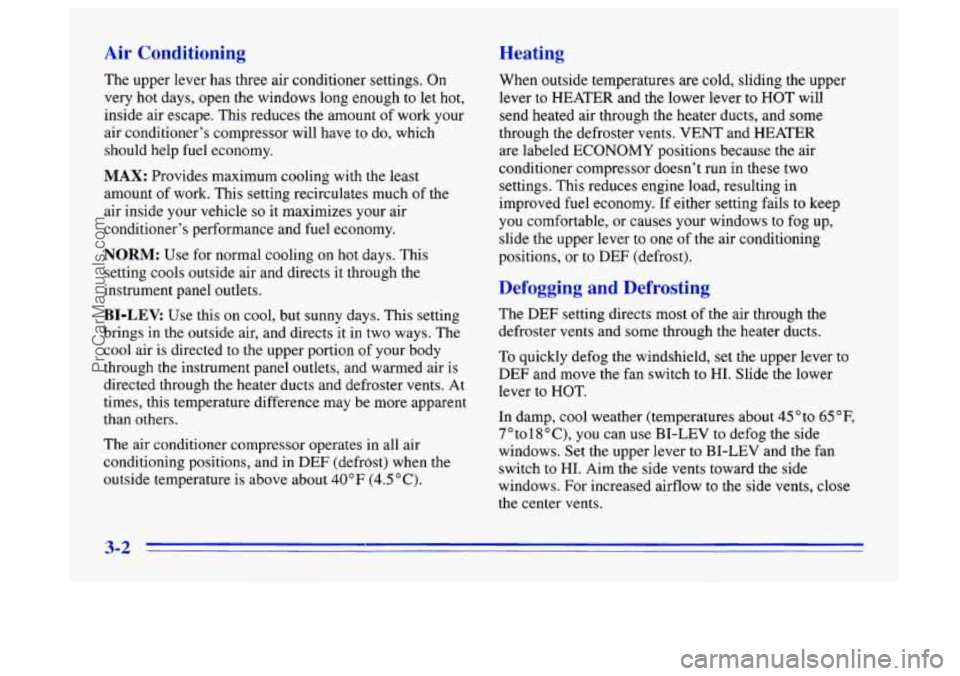
When outside temperatures are cold, sliding the upper
lever to HEATER and the lower lever to HOT will
send heated air through the heater ducts, and some
through the defroster vents. VENT and
HEATER
are labeled ECONOMY positions because the air
conditioner compressor doesn't run
in these two
settings. This reduces engine load, resulting in
improved fuel economy. If either setting fails to keep
you comfortable, or causes your windows to fog up,
slide the upper lever to one
of the air conditioning
positions, or to DEF (defrost).
The
upper lever has three air conditioner settings. On
very hot days, open the windows long enough to let hot,
inside air escape. This reduces the amount
of work your
air conditioner's compressor will have
to do, which
should help fuel economy.
MAX: Provides maximum cooling with the least
amount
of work. This setting recirculates much of the
air inside your vehicle
so it maximizes your air
conditioner's performance and fuel economy.
NORM: Use for normal cooling on hot days. This
setting cools outside air and directs it through the
instrument panel outlets.
BI-LEV: Use this on cool, but sunny days. This setting
brings
in the outside air, and directs it in two ways. The
cool air is directed to the upper portion of your body
through the instrument panel outlets, and warmed air is
directed through the heater ducts and defroster vents. At
times, this temperature difference may be more apparent
than others.
The air conditioner compressor operates in all air
conditioning positions, and in
DEF (defrdst) when the
outside temperature is above about
40°F (4.5"C).
r gii
The DEF setting directs most of the air through the
defroster vents and some through the heater dl
s.
To quickly defog the windshield, set the upper le ~ r to
DEF and move the fan switch to HI. Slide the lower
lever to HOT.
In damp, cool weather (temperatures about 45"to
65"F,
7 " to 18 " C), you can use BI-LEV to defog the side
windows. Set the upper lever to BI-LEV and the fan
switch to HI. Aim the side vents toward the side
windows, For increased airflow to the side vents, close
the center vents.
3-2
ProCarManuals.com
Page 121 of 340
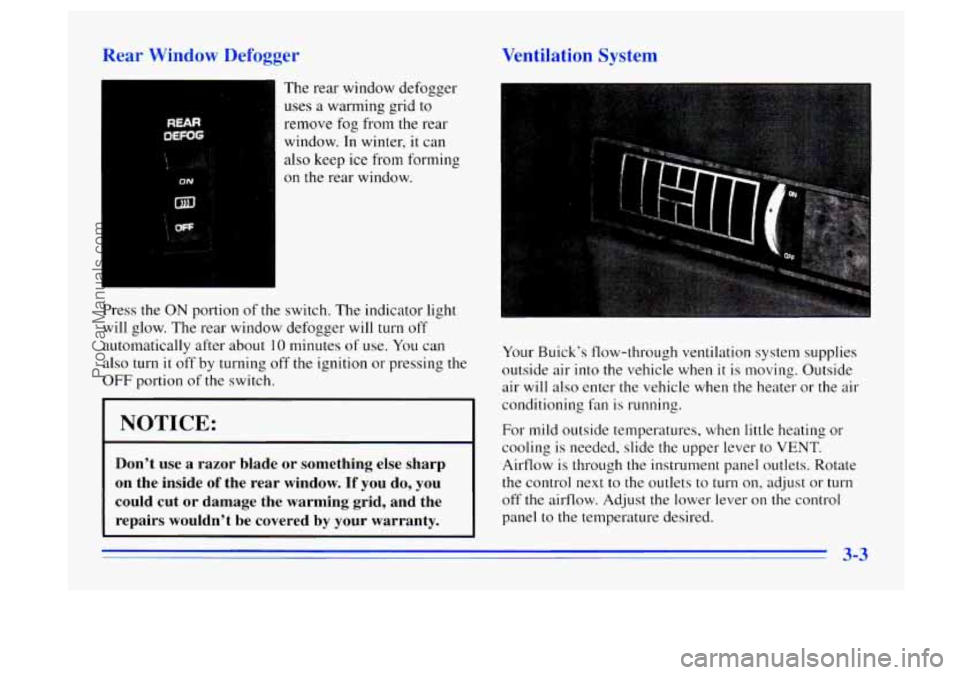
Rear Window Defogger
REAR
!
The rear window defogger
uses
a warming grid to
remove fog from the rear
window. In winter, it can
also keep ice from forming
on the rear window.
Press the
ON portion of the switch. The indicator light
will glow. The rear window defogger
will turn off
automatically after about 10 minutes of use. You can
also
turn it off by turning off the ignition or pressing the
OFF portion of the switch.
I NOTICE:
Don’t use a razor blade or something else sharp
on the inside
of the rear window. If you do, you
could cut or damage the warming grid, and the
repairs wouldn’t be covered by your warranty.
Ventilation System
Your Buick’s flow-through ventilation system supplies
outside air into the vehicle when
it is moving. Outside
air
will also enter the vehicle when the heater or the air
conditioning fan is running.
For mild outside temperatures, when
little heating or
cooling is needed, slide the upper lever to VENT.
Airflow is through the instrument panel outlets. Rotate
the control next to the outlets to turn on, adjust or turn
off the airflow. Adjust the lower lever
on the control
panel
to the temperature desired.
3-3
ProCarManuals.com
Page 258 of 340
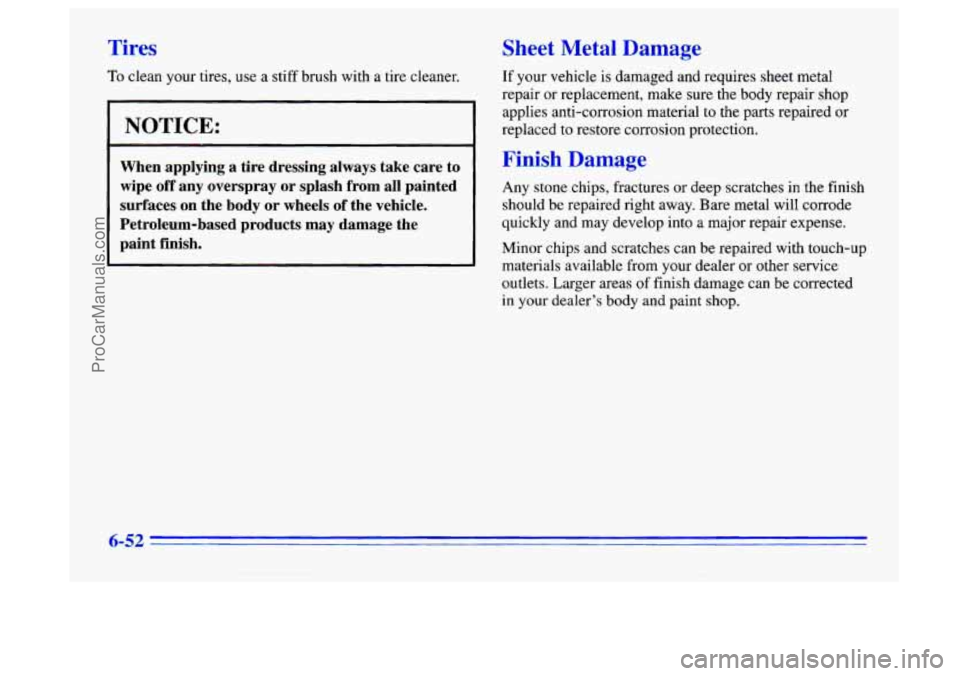
Tires
To clean your tires, use a stiff brush with a tire cleaner.
I NOTICE:
-
When applying a tire dressing always take care to
wipe off any overspray or splash from all painted surfaces on the body or wheels of the vehicle.
Petroleum-based products may damage the
paint finish.
Sheet Metal Damage
If your vehicle is damaged and requires sheet metal
repair or replacement, make sure the body repair shop
applies anti-corrosion material to the parts repaired or
replaced to restore corrosion protection.
Finish Damage
Any stone chips, fractures or deep scratches in the finish
should be repaired right away. Bare metal will corrode
quickly and may develop into a major repair expense.
Minor chips and scratches can be repaired with touch-up
materials available from your dealer or other service
outlets. Larger areas of finish damage can be corrected
in your dealer’s body and paint shop.
6-52
ProCarManuals.com